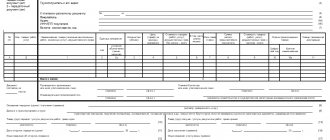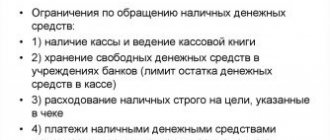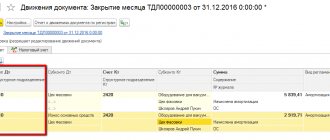In what standard currency is the document drawn up?
A document that provides the basis for the acceptance of goods or services, property rights, or work is called an invoice. A document from the seller is drawn up; the design and filling details are discussed in Government Decree No. 1137 “On the forms and rules for filling out (maintaining) documents used in calculations of value added tax” and in Federal Law No. 229. Read more about what details and how they are filled out in various invoices, we described here.
According to the standard model in the Russian Federation, invoices are issued in the currency that is accepted and established in Russia at the legislative level - in rubles.
The presence of a correctly completed document guarantees the return of VAT on the goods, services or work presented.
Purchase book and VAT (for the buyer of goods/works/services)
If the received invoice is issued by the seller in That is, the buyer will register it in the purchase book several times - at the time of receiving goods/work/services, and at the time of making a payment and creating an exchange rate difference.
If the invoice received is in rubles, then you must contact the seller to make corrections to the invoice on the date of payment. The buyer cannot use an invoice drawn up separately for exchange rate differences. In the sales book, the deduction adjustment is reflected as a cancellation of the original invoice - through an additional sheet (clause 7 of Resolution No. 914).
The buyer has the right to adjust VAT deductions due to exchange rate differences, either upward or downward:
- Letter of the Federal Tax Service of Russia dated April 19, 2006 N ШТ-6-03/ [email protected] (paragraph 2)
- Resolution of the Federal Antimonopoly Service of the Ural District dated April 11, 2005 N F09-1259/05-AK
When is it possible to deposit foreign money?
Is it possible to issue this document in foreign currency, in euros and dollars, for example? Yes, this is acceptable. Modern suppliers are increasingly purchasing goods from foreign stores and foreign partners. In this case, contracts are concluded in the currency of the selling country.
This is done to eliminate currency exchange rate fluctuations. This is beneficial for managers, but for Russian accountants it is difficult to calculate and transfer tax deductions.
For tax purposes, by law, the invoice is issued in rubles (according to Article 317 of the Civil Code of the Russian Federation - monetary obligations are indicated in rubles and are equivalent to conventional units or foreign money). In cases where purchases are made from foreign sellers, the documentation indicates the currency of the selling party and its code.
The Tax Code does not prohibit the use of foreign currency when filling out documentation. In cases where payment for goods or services is made in foreign money, the invoice can be drawn up indicating the foreign currency. Thus, the currency is indicated in cases of purchases, provision of services and transactions with foreigners, foreign stores and partners, if there is legislative permission.
Special publications by our experts will help you avoid making mistakes when filling out invoices, from which you will learn:
- What is a document number and what does the standard form look like?
- What are the rules for issuing invoices for services, advance payments and return of goods?
- What is the deadline for issuing an invoice to the buyer?
- What are the rules for filling out the document by separate divisions?
Invoice in foreign currency: instructions for use
In conditions of economic instability, suppliers who purchase goods from foreign partners are increasingly entering into contracts in conventional units.
In this case, dependence on currency exchange rate fluctuations is eliminated. Since settlements with residents in foreign currency are prohibited, payments under such agreements are made in rubles. This is beneficial for managers. But for accountants this is not an easy task. It is necessary to calculate the amount differences in accounting and tax accounting, despite the fact that the procedure for their calculation is not the same. In this article we will talk about how, according to tax authorities, in such cases, invoices should be issued and VAT calculated. Registration of invoices under contracts in conventional units and foreign currency
Calculation of value added tax under contracts in foreign currency (conventional units) raises many questions. Some of them remain unanswered. The position of officials in connection with the release of the Federal Tax Service letter dated August 24, 2009 No. 3-1-07/674 is clear: an invoice in foreign currency (conventional units) cannot be issued. Let's consider how legitimate the opinion of the tax authorities is and whether it is as clear as it seems at first glance. The officials' arguments are based on the fact that organizations are required to keep accounting records in rubles (Law No. 129-FZ). Consequently, all primary documents are compiled in rubles. Since the invoice is drawn up on the basis of the primary shipment document, the amounts in it should also be indicated in rubles. Making reference to Art. 317 of the Civil Code of the Russian Federation, tax officials remind that the monetary obligation must be expressed in rubles and can only be equivalent to foreign currency or conventional units. Let us note that previously tax specialists had a different opinion. Thus, the Tax Code does not contain a ban on issuing invoices in conventional units. Paragraph 7 of Article 169 of the Tax Code of the Russian Federation also does not establish a mandatory procedure for payments in rubles and allows invoices to be issued in foreign currency. Let us note that the tax authorities previously held this opinion (for example, letter from the Federal Tax Service in Moscow dated April 12, 2007 No. 19-11/33695). Thus, if the buyer takes advantage of deductions based on an invoice issued in conventional units or in a foreign currency, the tax authorities will most likely deny the deduction. The company will have to defend its right to deduct in court. There is no arbitration practice in this regard, since the Federal Tax Service’s letter was published not so long ago. A supplier who issues invoices in foreign currency does not face any liability, since there is no liability for incorrect execution of an invoice. ATTENTION! In this regard, tax inspectors allow the only exception. In their opinion, it is possible to draw up an invoice in conventional units only if payment under the contract will also be made in foreign currency. But such calculations are possible only in cases permitted by law. For example, under agreements with non-residents of the Russian Federation or when making payments under transport expedition agreements related to the movement of goods across the border of the Russian Federation. Another thing is that this makes no sense: under such agreements the buyer does not receive VAT reimbursement. And the seller who issued the invoice will clearly not be denied VAT. Before moving on to the registration of VAT accounting transactions, we note that, unlike the income tax, Chapter 21 “VAT” of the Tax Code of the Russian Federation does not contain the concept and does not regulate the accounting procedure for either exchange rate or amount differences (hereinafter, to avoid confusion, we will call the resulting differences in sum). However, they affect the calculation of the tax base for value added tax.
Preparation of invoices when amount differences arise
Amount differences in invoices should be reflected by making corrections to the previously issued invoice. The tax office recommends doing this. This approach is based on the fact that clause 29 of Government Resolution No. 914 of December 2, 2000 provides for the possibility of the taxpayer making corrections to invoices. Corrections to previously issued invoices must be certified by the signature of the manager and the seal of the seller, indicating the date of the correction. ATTENTION! Tax officials recommend that if you already have invoices issued in foreign currency (in conventional units), appropriate corrections should be made to them. For these purposes, it is necessary to exclude indicators in foreign currency (in conventional units) from columns 4, 5, 8 and 9 of the invoice and replace them with amounts in rubles. It should be noted that invoice corrections are not the only solution. Another option is to issue a new invoice to replace the previously issued one. According to experts from the Ministry of Finance, issuing duplicate (new) invoices is unlawful. Accordingly, it is impossible to deduct VAT amounts based on such invoices (letters of the Ministry of Finance of Russia dated April 1, 2009 No. 03-07-09/17, dated December 8, 2004 No. 03-04-11/217). The opinions of the judiciary are divided on this matter. Some courts support the position of officials (decision of the Supreme Arbitration Court of the Russian Federation dated July 22, 2008 No. 9252/08, dated June 26, 2008 No. 8039/08, resolution of the Federal Antimonopoly Service of the East Siberian District dated February 13, 2009 No. A19-9280/08- 51-Ф02-52/09). However, many courts side with taxpayers, pointing out that the current legislation does not contain a ban on replacing invoices with correctly executed ones (decision of the Supreme Arbitration Court of the Russian Federation dated October 29, 2008 No. 9961/08, dated October 16, 2008 No. 13689/08, resolution FAS Moscow District dated July 23, 2009 No. KA-A40/6878-09, resolution of the FAS North Caucasus District dated July 30, 2009 No. A53-5313/2007-C5-23, resolution of the FAS Ural District dated July 27, 2009 No. Ф09-5313/09-С3).
Accounting for amount differences
EXAMPLE. According to the purchase and sale agreement, the cost of the goods was $1,000. Payment will be made in rubles at the Central Bank exchange rate on the date of payment. The supplier shipped the products on September 10, 2009 at the rate of 30 rubles per dollar. The buyer made payment on November 20, 2009 at the rate of 35 rubles. for a dollar.
We take into account the amount differences from the seller on September 10, 2009
| D62 | — | K90 | — | 30,000 rub. ($1000x30) | — | Goods shipped |
| D90 | — | K68 | — | RUB 4,576.27 | — | VAT allocated |
We reflect VAT in the sales book (for convenience, we will display only the filled-in columns of the sales book): Sales book: September
| Seller's invoice date and number | Buyer's name | Buyer's TIN | Buyer checkpoint | Seller invoice due date | Total sales, including VAT | Including | |
| Taxable sales | |||||||
| 18% | |||||||
| Sales cost excluding VAT | VAT amount | ||||||
| (1) | (2) | (3) | (3a) | (3b) | (4) | (5a) | (5 B) |
| 111 from 10.09.09 | LLC "Buyer" | 740000000 | 740001001 | — | 30,000 rub. | RUB 25,423.73 | RUB 4,576.27 |
November 20, 2009
| D51 | — | K62 | — | 35,000 rub. ($1000x35 rub.) | — | Payment received from buyer |
| D62 | — | K91 | — | 5,000 rub. | — | Positive amount difference accrued |
| D91 | — | 68 | — | RUR 762.71 (5000x18/118) | — | VAT reflected on the amount difference |
Let us recall that the tax base determined on the date of shipment of goods, when used in calculations. e. is conditional in nature and cannot be taken into account according to the amount determined earlier than the tax period in which the payment was made. ATTENTION! The main question that arises for the seller is whether the VAT tax base is reduced due to the negative amount difference. For the first time, the tax authorities agreed that the tax base formed on the date of shipment is adjusted for the amounts of both positive and negative amount differences. This conclusion was made on the basis of established arbitration practice (Resolution of the Presidium of the Supreme Arbitration Court dated February 17, 2009 No. 9181/08). The Ministry of Finance, however, still does not agree with this. The Ministry of Finance’s arguments boil down to the fact that a positive difference that arises when the buyer pays for goods increases the VAT tax base, while a negative difference does not reduce it. In this regard, the tax service invites the seller to act as follows. At the time of payment, corrections must be made to the previously issued invoice, indicating the cost indicators in rubles at the exchange rate on the day of payment. The corrected invoice in the sales book for the shipment period is not canceled, and in the payment period it is again registered in the sales book, but only for the amount of the resulting positive or negative difference. Therefore, the supplier should make changes to the invoice (for convenience, we will only show the invoice columns that need to be corrected):
| Cost of goods (works, services), property rights, total without tax | Including excise tax | Tax rate | Tax amount | Cost of goods (works, services), property rights, total including tax |
| 5 | 6 | 7 | 8 | 9 |
| RUB 25,423.73 29,661.02 | — | 18% | RUB 4,576.27 5,338.98 | 30,000 rub. 35,000 |
Believe the corrected one. Director of Supplier LLC signature I. I. Ivanov 10.20.2009 Print We reflect VAT in the sales book (for convenience, we will display only the columns to be filled in): Sales book: October
| Seller's invoice date and number | Buyer's name | Buyer's TIN | Buyer checkpoint | Seller invoice due date | Total sales, including VAT | Including | |
| Taxable sales tax at the rate | |||||||
| 18% | |||||||
| Sales cost excluding VAT | VAT amount | ||||||
| (1) | (2) | (3) | (3a) | (3b) | (4) | (5a) | (5 B) |
| 111 from 10.09.09 | LLC "Buyer" | 740000000 | 740001001 | 20.10.09 | 5,000 rub. (35,000 -30,000) | RUB 4,237.29 (29,661.02 -25423.73) | RUR 762.71 (5,338.98 -4576,27) |
If the amount difference turns out to be negative, the VAT accounting procedure is carried out in a similar manner (with the only difference being that the entries in the book will have negative values). We take into account the amount differences from the buyer It is the buyers who will have to face the inconvenience caused by the new clarifications of the Federal Tax Service of Russia. So, since an invoice cannot be issued in conventional units, it must be received from the seller in rubles. September 10, 2009
| D41 | — | K60 | — | RUB 25,423.73 ($1000x30*100/118) | — | Goods received |
| D19 | — | K60 | — | RUB 4,576.27 | — | VAT reflected according to the invoice |
| D68 | — | K19 | — | RUB 4,576.27 | — | VAT accepted for refund |
We reflect VAT in the purchase book (for convenience, we will display only the filled-in columns of the purchase book):
Shopping Book: September
| Seller's invoice date and number | Seller invoice due date | date registration of goods (works, services), property rights | Seller's name | Seller's TIN | Seller checkpoint | Total purchases including VAT | Including | |
| Purchases subject to tax at the rate | ||||||||
| 18 percent | ||||||||
| Cost of purchases excluding VAT | VAT amount | |||||||
| (2) | (3) | (4) | (5) | (5a) | (5 B) | (7) | (8a) | (8b) |
| 111 from 10.09.09 | 10.09.09 | 10.09.09 | LLC "Seller" | 745300 00000 | 7453 01001 | 30,000 rub. | 25423, 73 rub. | 4576, 27 rub. |
November 20, 2009
| D60 | — | K51 | — | 35,000 rub. ($1000x35 rub.) | — | Payment transferred to the supplier |
| D91 | — | K60 | — | 4,237.29 (5,000x100/118) | — | Positive amount difference accrued |
| D19 | — | 68 | — | RUR 762.71 (5000x18/118) | — | VAT is reflected on the amount difference according to the invoice |
| D68 | — | 19 | — | RUR 762.71 | — | VAT on the amount difference is accepted for reimbursement* |
*Must obtain a corrected invoice from the seller
Changes must be made to the purchase ledger by canceling previous invoice entries. Additional sheet of purchase book No. 1 for September 2009
| Seller's invoice date and number | Seller invoice due date | Date of registration goods (works, services), property rights | Seller's name | Seller's TIN | Seller checkpoint | Total purchases including VAT | Including | |
| Purchases subject to tax at the rate | ||||||||
| 18 percent | ||||||||
| Cost of purchases excluding VAT | VAT amount | |||||||
| (2) | (3) | (4) | (5) | (5a) | (5 B) | (7) | (8a) | (8b) |
| Total* | 118,000 rub. | 100,000 rub. | 18,000 rub. | |||||
| 111 from 10.09.09 | 10.09.09 | LLC "Seller" | 745300 00000 | 7453 01001 | 30,000 rub. | RUB 25,423.73 | 4576, 27 rub. | |
| Total | 88,000 rub. | RUB 74,576.27 | 13423, 73 rub. | |||||
Let’s assume that the total purchases in the purchase book for September 2009 are 118,000 rubles, including VAT – 18,000 rubles. The corrected invoice is recorded in an additional sheet of the purchase ledger for the period in which the invoice was registered before the corrections. Additional sheet of purchase book No. 2 for September 2009
| Seller's invoice date and number | Seller invoice due date | Date of registration of goods (works, services), property rights | Seller's name | Seller's TIN | Seller checkpoint | Total purchases including VAT | Including | |
| Purchases subject to tax at the rate | ||||||||
| 18 percent | ||||||||
| Cost of purchases excluding VAT | VAT amount | |||||||
| (2) | (3) | (4) | (5) | (5a) | (5 B) | (7) | (8a) | (8b) |
| Total* | 88,000 rub. | RUB 74,576.27 | 13423, 73 rub. | |||||
| 111 from 10.09.09 | 20.10.09 | 10.09.09 | LLC "Seller" | 745300 00000 | 7453 01001 | 35,000 rub. | RUB 29,661.02 | 5338.98 rub. |
| Total | 123,000 rub. | RUB 104,237.29 | 18762.71 rub. | |||||
After making corrections to the purchase book, the taxpayer submits an updated tax return for the period in which the corrections were made. In our case, for the third quarter of 2009.
How to display data correctly?
- Rubles – the invoice indicates the name and digital code of the currency – “Russian ruble, code 643, RUB”.
- Dollars – “US dollar, code 840, USA.”
- Euro – “Euro, code 978, EUR”.
In the invoice, line number seven indicates the name of the currencies and their code value. The digital code is checked against the All-Russian Classifier. The price can be expressed in both Russian and foreign currencies, depending on the situation.
For example, when shipping goods in both currencies, the price in the invoice is expressed in different monetary units, or if the final result of the cost is indicated in the ruble, then the Russian currency is indicated in the line.
How to keep track of exchange rate and amount differences? Is it possible to continue to issue invoices in foreign currency?
Thus, the occurrence of amount differences is possible only in the case when any part of the payment is received after the date of shipment, on which the tax base for the purposes of calculating VAT is determined. Accordingly, if full advance payment is made, then on the date of shipment of the goods, regardless of exchange rate fluctuations, no amount differences arise.
Clause 7 of Art. 169 of the Tax Code of the Russian Federation establishes that if, under the terms of the transaction, the obligation is expressed in foreign currency, the amounts indicated in the invoice can be expressed in foreign currency. This paragraph specifically talks about the assessment of obligations, and therefore, this norm of the Tax Code of the Russian Federation applies not only to contracts with foreign partners, but also to contracts between Russian organizations in which the cost of goods (work, services) sold is expressed in foreign currency, and calculations are made in rubles.
We recommend reading: What a bailiff can seize
Violation of the law
When completing documentation, the name of the settlement currency and its digital code may be indicated incorrectly. In this case, the buyer will have problems when calculating VAT.
But taking into account the nuances of design, minor errors are allowed - for example, the code is not indicated, but only the name is present, this is acceptable in the document.
Articles 15, 25 of the Code of Administrative Offenses provide for administrative liability for violations in the field of currency turnover and regulation. Illegal currency transactions are actions related to illegal transfers and payments for goods and services that bypass tax deductions.
Monetary transactions associated with failure to comply with the requirements for foreign exchange transactions established at the legislative level - failure to use special reserve accounts, debiting/crediting amounts of money or external/domestic securities from accounts without fulfilling the requirements and reservation rules.
Income tax
In tax accounting, for ruble calculations of obligations in conventional units, the concept of “total difference” is used. Amount differences arise if the amount of obligations and claims incurred as of the date of sale (recording) of goods (work, services), property rights does not correspond to the actual amount received (paid) in rubles.
In tax accounting, amount differences are attributed to non-operating income (clause 7 of Article 271) and non-operating expenses (clause 9 of Article 272 of the Tax Code of the Russian Federation), and are recognized at the time of payment.
Amount differences are not taken into account
- With the cash method of accounting for income and expenses (clause 5 of Article 273 of the Tax Code of the Russian Federation).
- On a simplified taxation system (clause 3 of article 346.17 of the Tax Code of the Russian Federation).
Different approaches to the recognition of income and expenses in accounting and tax accounting entail temporary and permanent differences.
Issuing invoices for settlements in
The term “obligation” or “currency of obligation” is not disclosed by tax legislation, and therefore, using the rule of paragraph 1 of Art. 11 of the Tax Code of the Russian Federation, it is possible to determine in what meaning this term is used in the relevant branch of legislation - civil law. To do this, let us turn to the Civil Code of the Russian Federation (hereinafter referred to as the Civil Code of the Russian Federation).
- the period in which all conditions for deducting VAT are simultaneously met (Articles 171, 172 of the Tax Code of the Russian Federation) - the moment of receipt of the invoice before corrections are made to it;
- the period in which full payment for goods (work, services) occurred and final corrections were made to the invoice. However, this approach is allowed within a three-year period from the moment all the conditions for accepting VAT for deduction initially arose (clause 2 of Article 173 of the Tax Code of the Russian Federation, Letter dated April 30, 2009 N 03-07-08/105).
Interesting: Who is a tax resident of the Russian Federation
Association of International Road Carriers
1. To a counterparty (including a resident), with whom settlements are also carried out in foreign currency. This option is limited by the currency legislation of the Russian Federation. The list of transactions between residents of the Russian Federation that qualify for this option is listed in clause 1 of Art. 9 of the Law “On Currency Regulation” dated December 10, 2003 No. 173-FZ.
According to paragraph 7 of Art. 169 of the Tax Code of the Russian Federation, an invoice in foreign currency can be drawn up if the terms of the transaction in the contract are expressed in foreign currency. At the same time, in parallel with this norm of the Tax Code, there is another one in the legislation: sub-clause. "m" clause 1 section. Resolution II of the Government of the Russian Federation “On filling out documents for VAT calculations” dated December 26, 2011 No. 1137 states that if the obligation under the contract is fixed in currency equivalent, but the payment currency is rubles, the invoice should be issued in rubles.











